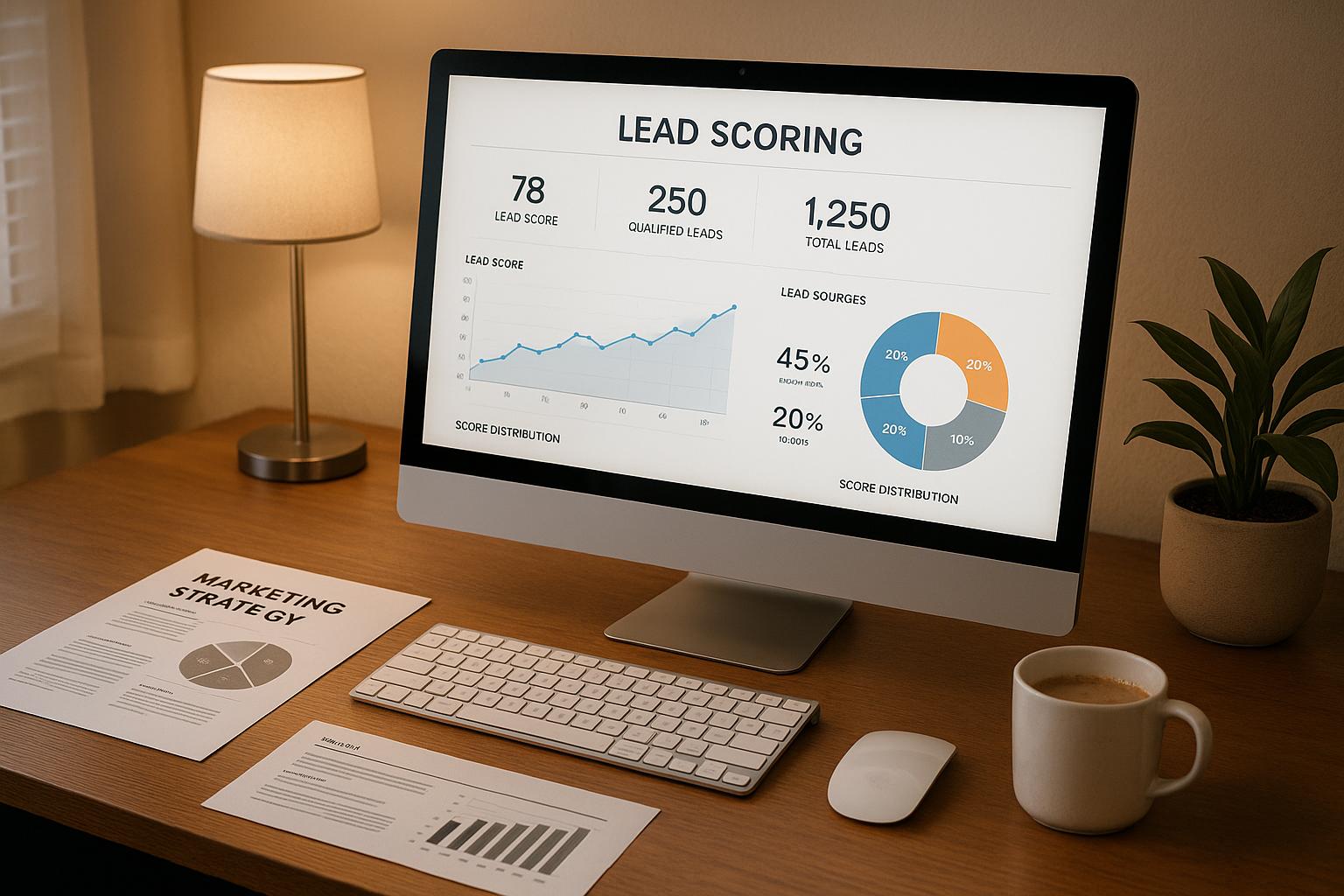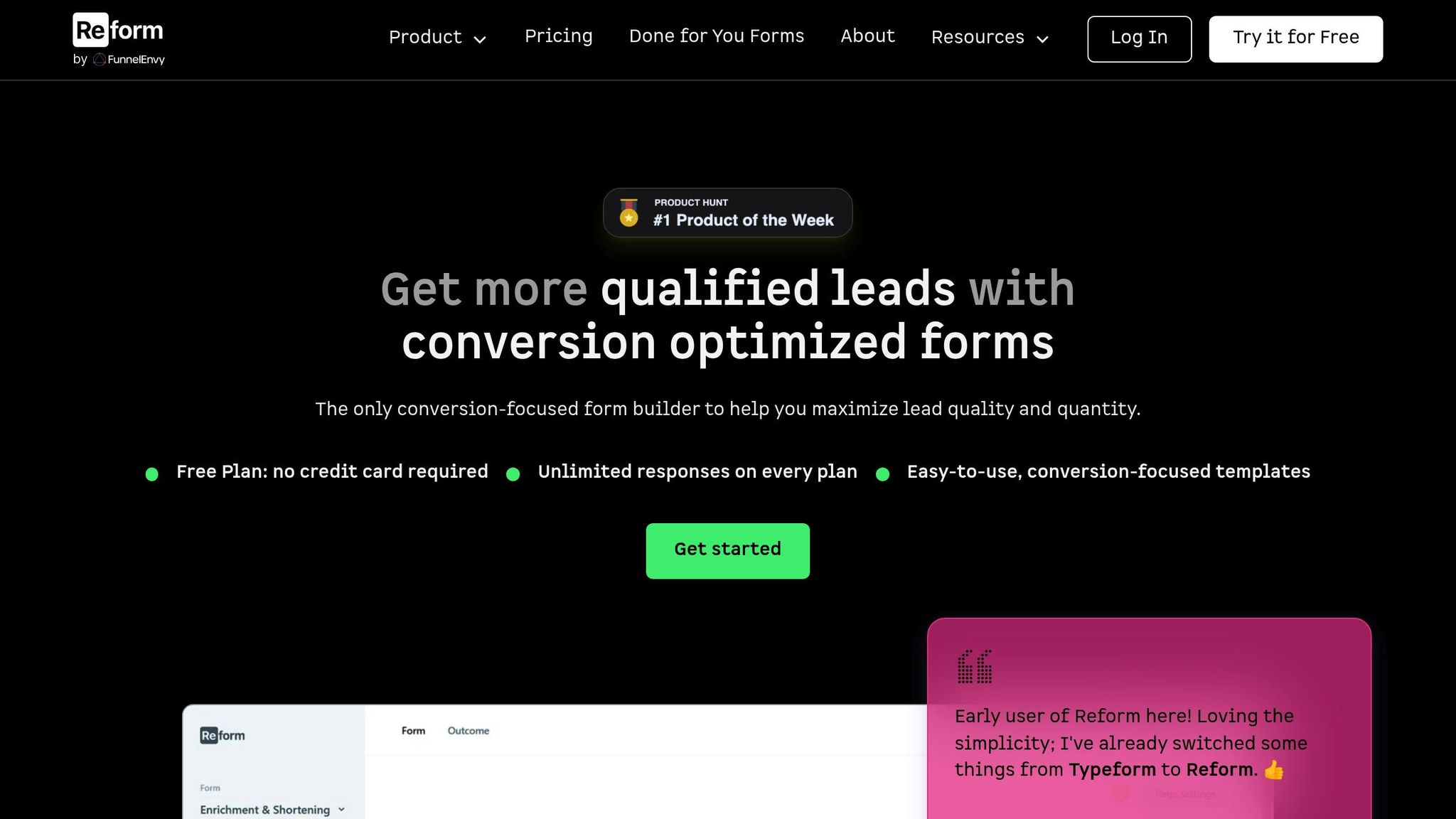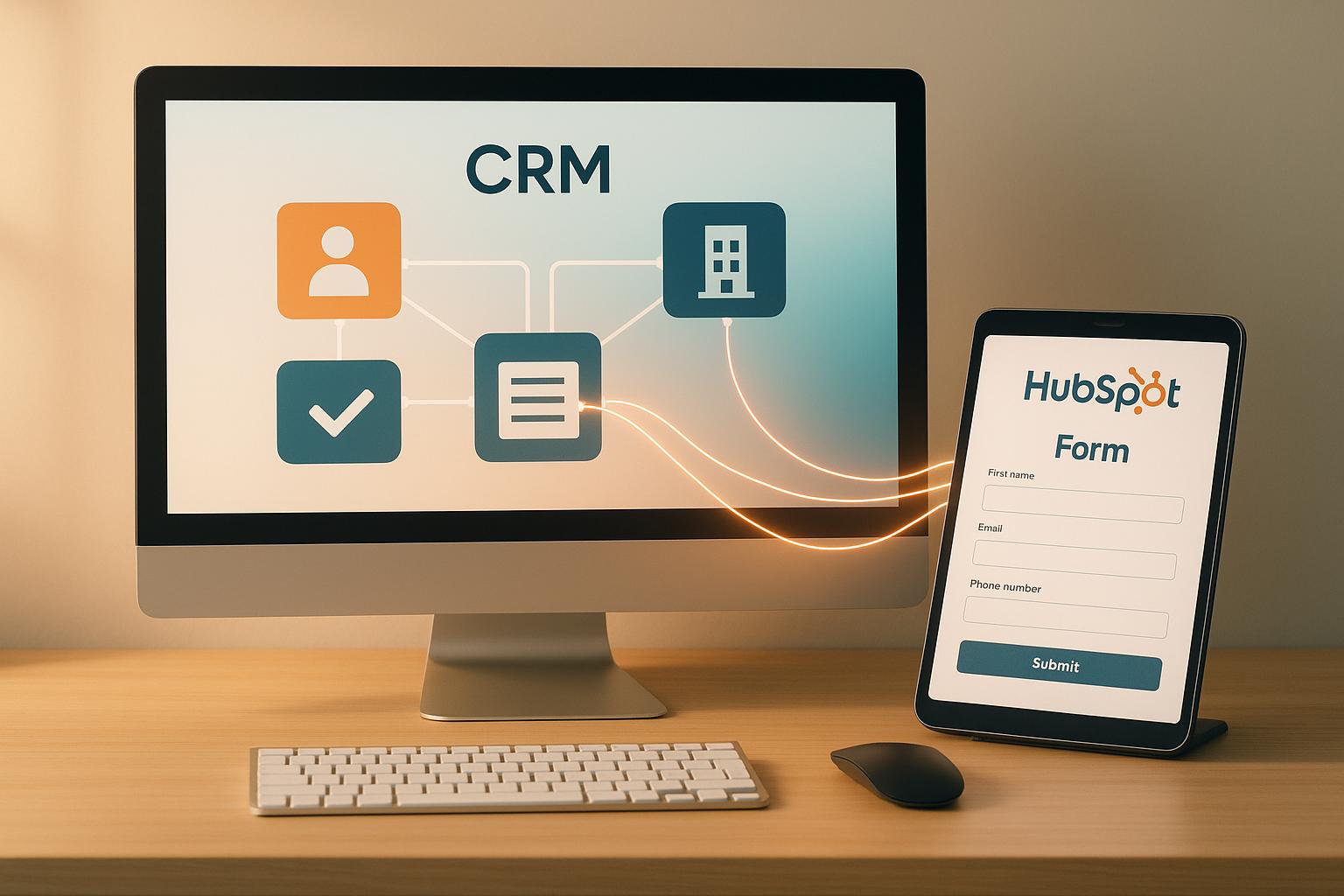How Lead Scoring Improves Marketing Automation

Lead scoring helps businesses focus on the leads most likely to convert by assigning scores based on actions (like visiting a pricing page) and demographics (like job title). This scoring integrates with marketing automation tools to trigger personalized actions - like sending emails or nurturing campaigns - based on a lead’s score. The result? Teams prioritize high-value leads, improve conversion rates, and reduce wasted effort.
Here’s why lead scoring matters:
- Prioritizes Leads: Focus on prospects ready to buy while nurturing others.
- Aligns Sales and Marketing: Clear scoring criteria reduce friction between teams.
- Improves Campaigns: Real-time data adjusts scores and refines strategies.
To succeed, use accurate data, set clear criteria, and regularly refine your scoring model. Tools like Reform simplify data collection and integrate seamlessly with automation systems, ensuring your efforts stay focused and effective.
What Is Lead Scoring In Marketing Automation? - BusinessGuide360.com
Key Benefits of Lead Scoring for Marketing Automation
When lead scoring joins forces with marketing automation, it creates a powerful system that reshapes how businesses handle potential customers. This combination enhances teamwork, sharpens lead focus, and boosts campaign effectiveness. Here are three major advantages of this partnership.
Aligning Sales and Marketing Teams
A common challenge in many businesses is the disconnect between sales and marketing. Marketing teams often aim to generate a large volume of leads, while sales teams prioritize lead quality. Lead scoring helps bridge this divide by defining what qualifies as a valuable lead. With a clear and consistent scoring system, both teams can agree on which prospects demand immediate attention and which ones need further nurturing.
This shared understanding fosters collaboration and reduces friction. Marketing gains confidence in the leads it hands over, knowing they meet agreed-upon criteria, and sales trusts that high-scoring leads represent real opportunities. It’s a win-win that encourages both teams to refine their approach using conversion data.
Prioritizing Leads More Effectively
Without lead scoring, sales teams might work through leads in the order they arrive or rely on gut feelings, often wasting time on prospects who aren’t ready to buy. Lead scoring changes the game by ensuring the most engaged prospects get immediate attention, while those requiring more time are placed into tailored nurturing campaigns.
For instance, if a prospect actively engages with multiple touchpoints - like reading detailed content, exploring pricing pages, and requesting further information - this behavior signals strong buying intent. Recognizing these high-value leads allows sales teams to focus their energy where it counts, leading to more meaningful interactions and better results.
Boosting Campaign Performance with Data Insights
Lead scoring doesn’t just improve prioritization; it also fine-tunes marketing campaigns. By analyzing how scores change, teams can identify which content and interactions resonate most with prospects. This data-driven approach helps allocate budgets more effectively and refine strategies to increase conversions. In short, lead scoring ensures resources are spent on what truly drives engagement and delivers results.
How to Build an Effective Lead Scoring Model
Creating a lead scoring model that truly works involves a clear plan, thoughtful criteria, and ongoing tweaks based on results. The goal? To streamline your marketing efforts and identify the most promising leads. Here's how to build a framework that delivers.
Defining Lead Scoring Criteria
A strong lead scoring model starts with identifying the key indicators of genuine interest. This means digging into your customer data to pinpoint the characteristics and actions that define your best leads.
Demographic criteria are a good starting point. These include things like company size, industry, job title, and location. For instance, a software company targeting large enterprises might assign higher scores to leads with titles like "Chief Technology Officer" at companies with over 500 employees. On the other hand, a local service provider would focus on prospects within their service area.
Behavioral signals carry even more weight because they show how engaged a lead is. Actions like clicking on emails, downloading resources, or requesting a demo are clear signs of interest. Tracking these behaviors across multiple touchpoints helps paint a full picture of a lead's engagement level.
Firmographic data is especially useful for B2B businesses. Details like annual revenue, team size, or the tools a company uses can help determine if a lead fits your ideal customer profile. For example, a marketing platform might prioritize leads already using tools like CRM software or email marketing systems.
Once you've identified these criteria, the next step is assigning points to reflect their importance.
Setting Points and Thresholds
After defining your criteria, it's time to assign point values and set thresholds that guide how leads are scored and categorized. The key is to balance simplicity with effectiveness.
Point allocation should mirror the importance of each action or trait. For example, opening an email might earn 1 point, while requesting a demo could be worth 15 points. Visiting a pricing page multiple times might add 10 points, whereas downloading a case study might contribute 20 points. This hierarchy ensures your scoring aligns with actual buying behavior.
Thresholds determine when a lead moves from one category to the next. For instance, a Marketing Qualified Lead (MQL) might need 50 points, signaling readiness for a nurturing campaign. A Sales Qualified Lead (SQL) might require 100 points, indicating they're ready for direct outreach. These thresholds should reflect your sales team's capacity and the length of your sales cycle.
Negative scoring is equally important for filtering out unqualified leads. For example, prospects who unsubscribe from emails, belong to companies outside your target market, or haven't engaged in months might lose points. This ensures your sales team focuses on leads with real potential.
A simple 0-100 point scale works well, with clear breakpoints like 25 for cold leads, 50 for warm leads, 75 for hot leads, and 100 for sales-ready prospects. This makes it easy for both marketing and sales teams to know where a lead stands and what to do next.
Refining the Scoring Model with Analytics
No lead scoring model is ever perfect - it needs regular adjustments based on performance data to stay effective. Treat your model as a living system that evolves with your business.
Track performance to see which criteria actually lead to conversions. For example, if leads who download whitepapers convert more often than expected, consider increasing the points for that action. If high-scoring leads frequently stall in the pipeline, reevaluate whether certain criteria are overvalued.
Feedback loops between marketing and sales teams are essential. Sales reps often notice patterns that data alone can't reveal. Regular discussions about lead quality and conversion rates help both teams fine-tune the model.
A/B testing is another powerful tool. Experiment with different point values or thresholds and measure how they impact conversions and sales velocity. This approach ensures any changes you make improve your results.
Quarterly audits are a must to keep your model up-to-date. Market trends shift, products change, and customer behaviors evolve. What worked six months ago might not work now. Regular reviews allow you to analyze data, gather feedback, and make necessary adjustments.
The best lead scoring models strike a balance between simplicity and effectiveness. While it’s tempting to track every data point, keeping things straightforward often delivers better results. Focus on what truly matters, assign meaningful point values, and continuously refine your system to stay ahead.
sbb-itb-5f36581
Using Reform to Improve Lead Scoring and Marketing Automation

The success of your lead scoring efforts relies heavily on the quality of the data you gather. If your data is flawed, you risk misjudging leads - wasting time on prospects who aren't ready to buy while overlooking genuine opportunities. Reform tackles this issue head-on by focusing on capturing accurate, high-quality lead information and effortlessly integrating it into your marketing automation systems.
Collecting Better Lead Data with Reform
One of the biggest challenges in lead scoring is collecting detailed, reliable data. Traditional forms often fall short, either by being too long and intimidating or too vague to provide meaningful insights. Reform changes the game with its multi-step forms, which break down complex questions into smaller, more manageable sections. This approach not only encourages more people to complete the forms but also gathers more detailed information about each lead.
Reform’s conditional routing feature takes things a step further by tailoring questions based on previous answers. For example, if a respondent identifies as a marketing manager, the form can ask about their team size or the tools they use. On the other hand, if the respondent is a CEO, it might focus on company revenue or growth goals. This ensures every piece of information is relevant and valuable for your lead scoring process.
To maintain data accuracy, Reform validates email addresses and blocks spam submissions. Plus, its real-time analytics and abandoned submission tracking provide insights into user behavior, such as where people drop off during the form process. These insights help you refine your forms and improve your lead scoring model based on actual engagement patterns.
Strengthening Lead Scoring with Enrichment and Analytics
Reform’s lead enrichment feature adds an extra layer of intelligence by automatically appending additional details - like company information and firmographic data - to form submissions. This eliminates the need to ask prospects for every detail, making forms shorter and less intimidating while still providing valuable insights for scoring.
The platform’s real-time analytics highlight which form elements drive conversions, helping you fine-tune your scoring criteria. For instance, if you notice a consistent drop-off at a specific question, it might signal that the question is unnecessary or needs to be rephrased. Reform also offers A/B testing, allowing you to compare different form structures and see how they impact lead quality. For example, you could test whether asking about budget earlier in the form improves scoring accuracy, even if it slightly lowers completion rates.
These insights not only enhance your scoring model but also feed directly into your automated marketing workflows, ensuring that your campaigns are always aligned with real-world behavior.
Seamless Integration for Automation
Reform integrates smoothly with popular marketing automation tools like ConvertKit and Zapier, and it’s expanding to include major CRM platforms like HubSpot and Salesforce. Once a prospect completes a Reform form, their data can automatically trigger the appropriate automation sequence, creating a seamless flow from data collection to lead nurturing.
For businesses that prioritize a customized user experience, Reform’s headless forms can be embedded directly into custom websites without sacrificing control over the design or functionality.
Additionally, Reform’s abandoned submission tracking helps you identify leads who started but didn’t finish a form. These partial submissions often indicate strong interest, making them ideal candidates for targeted nurturing campaigns. By using form responses to trigger tailored workflows, Reform ensures that your sales and marketing teams focus their efforts where they matter most - getting the right leads to the right people at the right time. This approach streamlines your lead management process and boosts efficiency across the board.
Conclusion: The Power of Lead Scoring in Marketing Automation
Lead scoring transforms marketing automation into a precision tool, helping businesses achieve more focused and impactful results. By automatically ranking leads based on their likelihood to convert, companies can allocate resources more effectively - focusing on prospects who are ready to make a purchase while nurturing those who require more time to decide.
But the advantages go beyond just prioritizing leads. A well-designed lead scoring system fosters stronger alignment between sales and marketing teams, minimizes time spent on unqualified prospects, and delivers actionable insights to fine-tune campaigns. When lead scoring is integrated into your marketing automation workflows, every interaction becomes more purposeful and targeted.
Of course, the effectiveness of lead scoring hinges on the quality of the data that powers it. Accurate and reliable data is the foundation of any successful scoring system. Reform simplifies this process with tools designed to ensure the data feeding your scoring model is both precise and relevant.
Reform’s built-in safeguards maintain the integrity of your lead database, ensuring it remains a valuable asset. When you combine advanced lead scoring with high-quality data collection, the results compound: better data drives more accurate scoring, which leads to more personalized automation, improved conversion rates, and sharper insights for future campaigns. This synergy between scoring and data quality elevates marketing automation to a whole new level.
This continuous cycle of improvement sets apart truly effective marketing automation strategies from basic email campaigns. For businesses aiming to get the most out of their marketing automation efforts, a strong lead scoring system paired with reliable tools is essential to staying competitive in today’s data-driven landscape.
FAQs
How can I keep my lead scoring model accurate and effective over time?
To ensure your lead scoring model stays accurate and works effectively, it's essential to update it regularly. Use the latest customer data and behavior patterns to fine-tune your approach. Adjust your scoring criteria to match shifts in your market and tweak point allocations so they align with your current business objectives.
One helpful technique is point decay, which reduces scores for leads that have become inactive over time. This keeps your data fresh and prevents outdated information from impacting your decisions. Regular reviews are also crucial - they can uncover errors or biases that might creep into your model, helping you keep it reliable and relevant. By staying on top of these adjustments, you'll be better equipped to focus on the right leads and boost your conversion rates.
What mistakes should I avoid when setting up lead scoring in marketing automation?
When setting up lead scoring, it's crucial to steer clear of relying on incomplete or inaccurate data. Doing so can throw off your entire system, leading to poor prioritization of leads. Aim to keep your scoring model straightforward and focused, prioritizing meaningful actions. For instance, avoid placing too much weight on low-intent activities like filling out a basic form or signing up for a webinar.
Another common misstep is ignoring data hygiene. If your data isn't regularly updated and cleaned, your scoring system can quickly lose its effectiveness. Make sure your scoring criteria genuinely reflect customer intent and align with your broader sales and marketing objectives. A clean, well-organized scoring system ensures you can consistently zero in on high-quality leads.
How does lead scoring help sales and marketing teams work better together?
Integrating lead scoring with marketing automation tools creates a unified approach for sales and marketing teams to prioritize leads effectively. By using objective criteria - like engagement levels or demographic alignment - teams can zero in on the prospects most likely to convert.
This shared system not only streamlines communication but also ensures seamless transitions between teams. When everyone works from the same data and objectives, workflows become more efficient, outreach becomes more precise, and conversion rates naturally improve.
Related Blog Posts
Get new content delivered straight to your inbox

The Response
Updates on the Reform platform, insights on optimizing conversion rates, and tips to craft forms that convert.
Drive real results with form optimizations
Tested across hundreds of experiments, our strategies deliver a 215% lift in qualified leads for B2B and SaaS companies.





